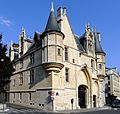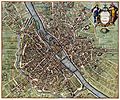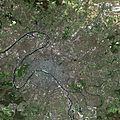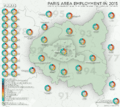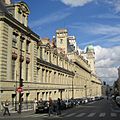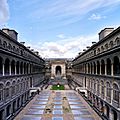Capital of France facts for kids
The capital of France is Paris. A country's capital city is usually where its government is located. While Paris is the capital today, France has had many different capital cities throughout its long history.
History of France's Capitals
France has a rich history, and its capital city has moved many times over the centuries. This happened for different reasons, like wars, changes in rulers, or important political events. Let's explore some of these changes.
Where France's Capital Has Been
Here is a list of the cities that have served as the capital of France:
- Tournai (before 486)
- Soissons (486-around 900)
- Paris (900-1419) Paris was the home of the kings of France for a long time. However, kings were usually crowned in Reims.
- Orléans (1108) One king, Louis VI the Fat, was crowned here instead of Reims. Also, the French government met here for a short time in 1560-1561.
- Troyes (1419–1422) During the Hundred Years' War, this city briefly became the center of the royal government.
- Bourges (1422–1444) King Charles VII had to leave Paris and made Bourges his capital.
- Tours (1444—1527) King Louis XI chose a castle near Tours as his main home.
- Paris (1428—1588) King Francis I set up his royal court in Paris.
- Tours (1589—1594) A group of lawmakers loyal to the king met in Tours during this period.
- Paris (1594—1661)
- Paris (1661-1682) Paris was the official capital. But King Louis XIV wanted Versailles to be the main political center.
- Versailles (1682–1715) In 1682, King Louis XIV moved his royal home to Versailles.
- Paris (1715–1722)
- Versailles (1722–1789) In 1789, people from Paris marched to Versailles. They forced the royal family to move back to Paris. The National Assembly, which was the government, also moved to Paris. This made Versailles lose its role as the capital.
- Paris (1789–1871)
- Versailles (1871–1879) After the Paris Commune took control of Paris, the new French government (the French Third Republic) moved its base to Versailles in March 1871.
- Paris (1879–1914, 1914-1940)
- Bordeaux (September 1914) At the start of World War I, the French government briefly moved from Paris to Bordeaux. They were worried Paris might be captured by German forces. These fears ended after the Germans were pushed back at the First Battle of the Marne.
- Tours (10–13 June 1940) During World War II, Tours was a temporary capital. The government fled Paris because of the German army's advance.
- Bordeaux (June 1940) The French government moved again from Tours to Bordeaux. This happened very quickly as it became clear Paris would soon fall to Germany.
- Vichy (1940-1944) The French Parliament met here and changed the government to the French State.
- Paris (1944–present) When Paris was freed in 1944, Charles de Gaulle set up a new government. This brought Paris back as the capital of France.
Images for kids
-
The Palais de la Cité and Sainte-Chapelle, viewed from the Left Bank, from the Très Riches Heures du duc de Berry (month of June) (1410)
-
The storming of the Bastille on 14 July 1789, by Jean-Pierre Houël
-
The Panthéon, a major landmark on the Rive Gauche, was completed in 1790.
-
The Eiffel Tower, under construction in November 1888, startled Parisians — and the world — with its modernity.
-
General Charles de Gaulle on the Champs-Élysées celebrating the liberation of Paris, 26 August 1944
-
Camille Pissarro, Boulevard Montmartre, 1897, Hermitage Museum
-
The Eiffel Tower and the La Défense district
-
Tourists from around the world make the Louvre the most-visited art museum in the world.
-
The Axe historique, pictured here from Concorde to Grande Arche of La Défense
-
Pierre Mignard, Self-portrait, between 1670 and 1690, oil on canvas, 235 cm × 188 cm (93 in × 74 in), The Louvre
-
Auguste Renoir, Bal du moulin de la Galette, 1876, oil on canvas, 131 cm × 175 cm (52 in × 69 in), Musée d'Orsay
-
The Comédie Française (Salle Richelieu)
-
Salah Zulfikar and Sabah in Paris and Love (1972)
-
Le Zimmer, on the Place du Châtelet, where Géo Lefèvre first suggested the idea of a Tour de France to Henri Desgrange in 1902
-
Les Deux Magots café on Boulevard Saint-Germain
-
Magdalena Frackowiak at Paris Fashion Week (Fall 2011)
-
Republican Guards parading on Bastille Day
-
The main building of the former University of Paris is now used by classes from Sorbonne University, New Sorbonne University and other autonomous campuses.
-
2010 Tour de France, Champs Élysées
-
The French Open, played on red clay, is one of four Grand Slams in professional tennis.
-
The Paris Métro is the busiest subway network in the European Union.
-
In 2020 Paris–Charles de Gaulle Airport was the busiest airport in Europe and the eighth-busiest airport in the world.
-
The Passerelle de l'Avre, crossing the Seine and establishing a link between the Bois de Boulogne and Saint-Cloud in Hauts-de-Seine, is the City of Paris's westernmost point.
-
The Paris Catacombs hold the remains of approximately 6 million people.
-
Column dedicated to Paris near the Baths of Diocletian in Rome
See also
 In Spanish: París para niños
In Spanish: París para niños




